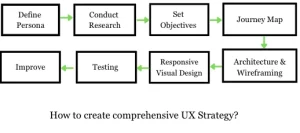How to Create Comprehensive UX Strategy?
A seamless and engaging user experience (UX) is at the heart of successful digital products and services. To achieve this, businesses must develop a comprehensive UX strategy that aligns with user needs and business goals.
This blog will explore the key steps in creating a comprehensive perfect strategy that ensures a delightful user experience and drives business success. From defining user personas to conducting user research, mapping user journeys, and iterating through testing, we will provide you with actionable insights and practical tips to create a strategy that sets you apart from the competition.
Get ready to enhance user satisfaction, increase conversions, and unlock the full potential of your digital interfaces with a well-crafted user experience strategy.
What is a Comprehensive UX Strategy?
A comprehensive UX (User Experience) strategy refers to businesses’ systematic and holistic approach to designing and optimizing the user experience of their digital products, services, or interfaces.

- A design strategy in ux involves a thorough understanding of user needs, goals, and behaviors and aligning business objectives to create seamless and engaging interactions.
- A comprehensive strategy encompasses various elements, including user research, persona development, user journey mapping, information architecture, wireframing, prototyping, visual design, usability testing, and continuous iteration.
- UX strategy aims to enhance user satisfaction, drive conversions, and deliver a positive and memorable user experience across all touchpoints.
Read: What is Strategy Consulting?
What are the Benefits of Comprehensive UX Strategy?
You need UX (User Experience) because it ensures your digital products or services are intuitive, enjoyable, and meet user needs, resulting in higher user satisfaction and increased business success.
UX enhances engagement, boosts conversions, and builds positive brand perceptions, ultimately driving customer loyalty and competitive advantage.

Benefits of a Comprehensive Strategy:
- Enhanced User Satisfaction: By investing in a comprehensive UX strategy, businesses can create digital experiences that meet and exceed user expectations. This increases user satisfaction, as the interfaces are designed to meet user needs and preferences. A positive user experience builds trust, encourages engagement, and fosters customer loyalty.
- Improved Conversion Rates: A well-executed strategy can significantly impact conversion rates. Businesses can guide users towards desired actions by optimizing the user journey, removing friction points, and designing intuitive interfaces, such as purchasing, filling out a form, or subscribing to a service. This results in improved conversion rates and a higher return on investment.
- Increased User Engagement: Engaged users are more likely to interact with a digital product or service, explore its features, and spend more time on the platform. A comprehensive strategy focuses on creating engaging experiences through intuitive navigation, interactive elements, personalized content, and gamification techniques. This increases user engagement, encourages repeat visits, and fosters a sense of connection with the brand.
- Reduced User Errors and Support Costs: A user-friendly and intuitive interface helps to minimize user errors and the need for customer support. Businesses can reduce user confusion and frustration by conducting thorough user research, implementing clear information architecture, and providing helpful cues and feedback. This leads to decreased support inquiries, lower support costs, and improved user satisfaction.
- Competitive Advantage: A comprehensive strategy can provide a significant competitive advantage in today’s crowded digital landscape. By delivering exceptional user experiences, businesses differentiate themselves from competitors and establish themselves as industry leaders. A positive reputation for usability and user-centric design can attract new customers, retain existing ones, and build a strong brand image.
- Higher User Retention: Users are likely to continue using a product or service if they have a positive experience. A comprehensive strategy focuses on creating delightful interactions, personalized experiences, and seamless flows. This enhances user retention and reduces churn rates, leading to long-term customer relationships and increased lifetime value.
- Positive Brand Perception: A well-designed and user-centric interface reflects positively on the brand. A comprehensive strategy helps businesses create a consistent brand identity, convey professionalism, and establish trustworthiness. Users perceive brands prioritizing the user experience as reliable, customer-centric, and forward-thinking.
- Data-Driven Decision Making: A comprehensive strategy involves gathering and analyzing user data for design decisions. Businesses can make data-driven optimizations and improvements by leveraging user feedback, conducting usability tests, and analyzing user behavior metrics. This leads to continuous enhancements and a better understanding of user preferences and needs.
How to Create a Comprehensive UX Design Strategy?
A UX design strategy helps by improving user satisfaction, increasing conversions, enhancing engagement, reducing support costs, gaining a competitive edge, boosting user retention, creating positive brand perception, and enabling data-driven decision-making, ultimately leading to business success and customer loyalty.
Let us see how you can create a Comprehensive UX Design Strategy:
A comprehensive UX (User Experience) strategy is crucial for businesses to provide their users a seamless and engaging experience. Here are the key steps to creating a comprehensive UX strategy:

- Define User Personas: Understand your target audience by creating user personas based on research and data. Identify their needs, goals, behaviors, and preferences to inform your UX strategy.
- Conduct User Research: Gather insights through user research methods such as surveys, interviews, and usability testing. Identify pain points, challenges, and opportunities to optimize the user experience.
- Set Clear Objectives: Define specific goals and objectives for your UX strategy. These include improving conversion rates, reducing bounce rates, increasing user engagement, or enhancing overall satisfaction.
- Map User Journeys: Visualize the user journey from initial interaction to conversion. Identify touchpoints, exchanges, and potential friction points to optimize the flow and enhance user satisfaction.
- Information Architecture: Create a clear, intuitive architecture that logically organizes content and functionality. Use card sorting and tree testing to ensure easy navigation and findability.
- Wireframing and Prototyping: Develop wireframes and prototypes to visualize your digital interfaces’ layout, structure, and functionality. Test and iterate on these prototypes to refine the user experience before implementation.
- Visual Design: Create visually appealing designs that align with your brand identity and resonate with your target audience. Use color, typography, imagery, and other visual elements to enhance your interfaces’ aesthetic appeal and usability.
- Responsive and Mobile-First Design: Ensure your interfaces are optimized for a seamless experience across various devices and screen sizes. Adopt a mobile-first approach to prioritize mobile users’ needs and deliver a consistent experience.
- Usability Testing: Conduct usability tests to gather feedback and identify areas for improvement. Test your interfaces with real users to validate the effectiveness of your UX strategy and make data-driven optimizations.
- Continuous Iteration and Improvement: UX is an ongoing process. Continually monitor user feedback, analyze user behavior metrics, and iterate on your designs to refine the user experience and meet evolving user needs.
Brand Example of Comprehensive Strategy
An example of an Indian brand that has implemented a comprehensive UX strategy is Flipkart. Flipkart, an e-commerce giant, has focused on delivering customers a seamless and user-friendly experience.
They have invested in a user-centric approach by understanding their target audience, conducting user research, and creating intuitive interfaces.
Flipkart’s UX strategy includes personalized recommendations, easy navigation, clear product information, user reviews, and a hassle-free checkout process.
By prioritizing user needs and continuously iterating based on user feedback, Flipkart has gained a competitive edge, achieved high customer satisfaction, and become one of India’s leading e-commerce platforms.
Conclusion
Creating a comprehensive UX strategy is essential for businesses to thrive digitally. By prioritizing user needs, conducting thorough research, mapping user journeys, optimizing interfaces, and continuously iterating based on user feedback, businesses can deliver exceptional user experiences, drive conversions, and gain a competitive advantage.
A comprehensive UX strategy enhances user satisfaction, boosts engagement, reduces support costs, and builds a positive brand perception. By embracing a user-centric approach and investing in a well-crafted UX strategy, businesses can unlock the full potential of their digital interfaces and pave the way for long-term success.
Connect with us at hello[at]noboruworld.com if you want comprehensive UX strategy services.
FAQ
What is a comprehensive UX strategy?
A comprehensive UX strategy refers to a holistic plan that outlines the approach and principles for delivering exceptional user experiences across all touchpoints of a product or service. It involves understanding user needs, aligning business goals with user goals, defining design principles, and implementing UX best practices throughout the user journey.
Why is a comprehensive UX strategy important?
A comprehensive UX strategy is important because it helps create user-centric products and services that meet customer needs, enhance satisfaction, and drive business success. It enables companies to differentiate themselves in the market, increase user engagement and loyalty, and improve conversion rates. A well-defined UX strategy also helps align cross-functional teams and ensures a consistent and seamless user experience.
How does a comprehensive UX strategy impact business goals?
A comprehensive UX strategy impacts business goals by creating user experiences that drive customer satisfaction, engagement, and loyalty. Companies can increase customer retention, boost conversion rates, and generate positive word-of-mouth by meeting user needs effectively. A well-designed and user-friendly product or service can also differentiate a business from its competitors, leading to increased market share and profitability.
How can I measure the success of a comprehensive UX strategy?
The success of a comprehensive UX strategy can be measured using various metrics, including user satisfaction surveys, usability testing results, conversion rates, user retention rates, and engagement metrics (such as time spent on site and interaction rates). Gathering qualitative and quantitative data allows for continuous evaluation and improvement of the UX strategy.
Who should be involved in developing a comprehensive UX strategy?
Developing a comprehensive UX strategy requires cross-functional collaboration. Key stakeholders typically include UX designers, product managers, developers, marketers, customer support representatives, and executives. Involving representatives from different departments ensures a holistic perspective and alignment between business goals and user needs.



